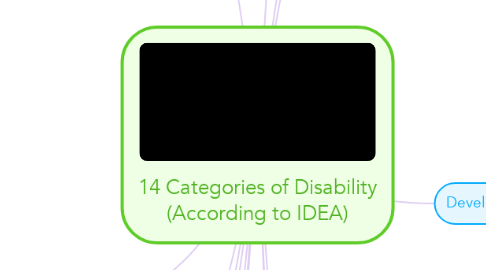
1. Emotional Disturbance
1.1. A condition exhibiting one or more of the following characteristics, which adversely affects their educational experience.
1.1.1. An inability to build or maintain satisfactory interpersonal relationships with peers and teachers.
1.1.2. Inappropriate types of behaviors or feelings under normal circumstances
1.1.3. A general pervasive mood of unhappiness or depression.
1.1.4. A tendency to develop physical symptoms or fears associated with personal or school problems.
1.1.5. An inability to learn that cannot be explained by intellectual, sensory, or health factors.
1.2. Modification: A child with an emotional disturbance can benefit from a modification in setting. Working one-on-one with a teacher may help them feel supported and tended to.
2. Hearing Impairment
2.1. CASE STUDY: John has an "invisible" disability in college, a hearing impairment which requires him to have a note taker in class. He is extremely sensitive towards what his classmates might think of this and fears social rejection or stereotypes such as him being stupid or lazy.
2.1.1. Solution: "Intervention from the student disability resources office included contact with the instructor who then made a general announcement in class about the need for a note taker, noting that monetary compensation would be provided; if there were no volunteers, the disability resources office staff would recruit on campus for a paid note taker enrolled in the class.
2.1.2. Recommendations: It was also recommended that the instructor provide lecture outlines and the option for the student to tape record the lectures. Additional support was provided to the student through disability management counseling, which reinforced self-advocacy and learning skills."
2.2. Modification: A student with a hearing impairment may benefit from a modification in the materials. For example providing audiotaped lectures or books. Another example would be a note-taker like is the example in the case study.
3. Intellectual Disability
3.1. Modification: Intellectually disables students will benefit from a modification in instruction. Reducing the difficulty of assignments, reducing the reading level and using a student/peer tutor will all be beneficial.
4. Multiple Disabilities
4.1. Modification: Students who suffer from multiple disabilities may benefit greatly by having an aid in their classroom which provides them with individualized attention.
5. Orthopedic Impairment
5.1. Modification: Depending on the illness, the school can provide modifications like special equipment, modified desks, and a handicapped safe school.
6. Specific Learning Disability
6.1. Includes conditions such as perceptual disabilities, brain injury, minimal brain dysfunction, dyslexia, and developmental aphasia.
6.2. Modification: A student with a specific learning disability may benefit from a modification in setting. Working in a small group as well as one-on-one with the teacher may help them immensely.
7. Speech or Language Impairment
7.1. Modification: A student with a speech or language impairment may benefit from a modification in instruction. Perhaps reducing the reading level or reducing the difficulty of assignments may help.
8. Visual Impairment, Including Blindness
8.1. Modifications: A visually impaired student may benefit by a teacher proving audiotaped lectures or books. The student response may also be modified by allowing them to answer orally or dictated.
9. Autism
9.1. Engaging in repetitive activities and stereotyped movements
9.2. Resistance to environmental change or change in daily routine
9.3. Unusual responses to sensory experiences
9.4. Case Study:
9.4.1. Joey is a fiveyear-old boy who was has autism. Joey has emerging verbal skills as he speaks mostly in oneword requests, however he will occasionally put together up to four word sentences.
9.4.2. Joey is currently included in a general education pre-school class and is accompanied by an aid. The pre-school is called Small People Preschool and is a half-day program. The room has three adults including one teacher, one teacher’s aid, and Joey’s aid. The pre-school has twenty-one children in the class
9.4.3. A structured classroom setting, with a collaborative atmosphere and the help of the aid and the teacher helped Joey excel in this preschool as opposed to his previous traditional pre school where he had no adaptations.
9.5. Modification: Providing an aid to autistic children is the best solution. The aid must know what type of autism the child is suffering from to be able to better tend to the students needs.
10. Deaf-Blindness
10.1. Modification: Using sign language, a communication device, Braille, or native language if it is not English
11. Deafness
11.1. Modification: A modification in the instruction method like using sign language is the best thing to do for deaf students.
12. Developmental Delay
12.1. Modification: A modification in scheduling is the best type of modification that way they are allowed more time to complete assignments and may take tests over a longer period of time
12.2. Each state defines their own term for developmental delay which means a delay in the following areas:
12.2.1. Adaptive (Behavioral) Development
12.2.2. Communication
12.2.3. Cognitive Development
12.2.4. Physical Development
12.2.5. Social or Emotional Development
